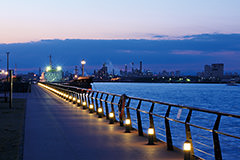[Part 4] How to Make Good Use of the Self-timer and Shutter Speed
Besides the use of a tripod for taking nightscape shots, using the self-timer and adjusting the shutter speed are also effective techniques when you want to prevent vibrations from being transmitted to the camera or when you want to capture a smooth water surface. In this article, let's try to learn how to make good use of the settings to enhance your nightscape photos. (Reported by: Takuya Iwasaki)

Pages: 1 2
Preventing Vibrations from Being Transmitted to the Camera
Wooden decks are commonly found at nightscape spots such as beaches, but taking photos on the deck can be challenging as camera shake occurs each time someone walks past. If there are people near the camera, it may be necessary to introduce measures such as using the self-timer or increasing the shutter speed. Also, carbon tripods are capable of absorbing vibrations, and may thus help to reduce camera shake.
Camera Function to be Used

Self-timer
Make use of the 2-second self-timer function to help reduce camera shake caused by vibrations from people passing by.
Technique: Deck … Avoid Camera Shake with Self-timer and Shutter Speed
You can find many places installed with wooden decks, such as at well-equipped parks and outdoor observation decks. One of the challenges with photographing on a wooden deck is that it is unstable and is likely to cause camera shake, particularly when there are people passing by or children running around. To produce blur-free shots on a deck, make use of the 2- to 10-second self-timer, and move yourself away from the deck. Also, increase the shutter speed. By raising the ISO speed or opening up the aperture toward the maximum, you can obtain sharp photos with an exposure time of about 2 to 4 seconds. It would also be good to choose a weekday when there are less people.

EOS 5D Mark II/EF24-105mm f/4L IS USM/ 65mm/Manual exposure (4 sec., f/8)/ ISO 800/ WB: White fluorescent light
As vibrations get transmitted easily from under the feet to the tripod, I prevented myself from moving, and increased the shutter speed as much as possible so that camera shake does not occur. The light rays are also sharply depicted in this shot.

Generally, digital SLR cameras come with a 2-second self-timer feature, which comes in handy when you do not have a remote shutter release.

While it is easy to mount a tripod on the wooden decks commonly found at night view spots such as seaside, vibrations from people walking nearby may be transmitted easily to the camera.
Expressing Light Reflections from the Water Surface Attractively
When you are photographing nightscapes on the other side of a river, for example, the key lies in how light reflected from the water surface can be captured attractively. To express the reflections on the water surface, use Shutter-priority AE or manual exposure so that a slower shutter speed can be obtained. Also, pay attention to select a low ISO speed so that the resulting quality is clear with minimal noise. In this case, the Long exposure noise reduction feature is indispensable.
Camera Function to be Used

Shutter Speed
Capturing a smooth water surface helps to bring out the reflections on the water surface. To do so, a long exposure time is necessary.
Technique: Opposite Shore…Slow Shutter Speed for a Smooth Water Surface

EOS 5D Mark II/ EF17-40mm f/4L USM/ FL: 25mm/ Shutter-priority AE (15 sec., f/11, ±0EV)/ ISO 200/ WB: White fluorescent light
To produce a smooth depiction of light reflected from the water surface, I selected a slow shutter speed. The resulting image appears crystal-clear.
It is comparatively easy to capture shots of a nightscape located on the other side of a river or bay. If both you and the camera are standing on a concrete ground, camera shake is unlikely to occur unless the wind is extremely strong. A tip to capturing the night view on the opposite shore beautifully is to pay attention to the light reflections from the water surface. In nightscape photography, you can generally obtain a clear photo by using Aperture-priority AE. However, if your subject is located across the river or bay, you need to make the rippling water surface appear quiet. To do so, the key is to make use of a slow shutter speed so that the water surface would turn out smooth. In this case, therefore, you are recommended to select Shutter-priority AE and set the shutter speed to about 15 to 30 seconds. A long exposure time allows the water surface to appear calm, thus bringing out the reflections clearly.
Water Surface at Different Shutter Speeds

0.4 sec.
Light reflections from the water cannot be captured beautifully due to the ripples. It would be desirable if the water surface could appear smoother.

3.2 sec.
The water surface appears much smoother, but the light reflections still seem wavy, giving a blurry impression.

25 sec.
The water surface is smooth, and the light reflections are clearly depicted.

Born in 1980 in Osaka. After graduating from the Faculty of Economics, Hosei University, Iwasaki became a nightscape photographer in 2003. He works as a guide for All About (http://allabout.co.jp) as well as a lecturer for Tokyu Seminar BE's "Night Photography Course".
http://www.yakei-photo.jp/

A monthly magazine that believes that enjoyment of photography will increase the more one learns about camera functions. It delivers news on the latest cameras and features and regularly introduces various photography techniques.
Published by Impress Corporation

































